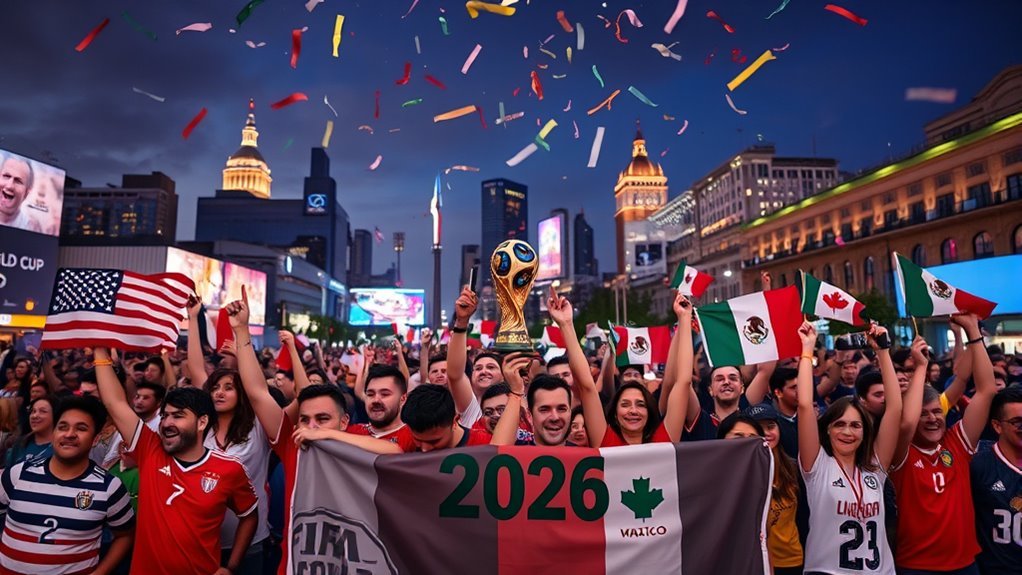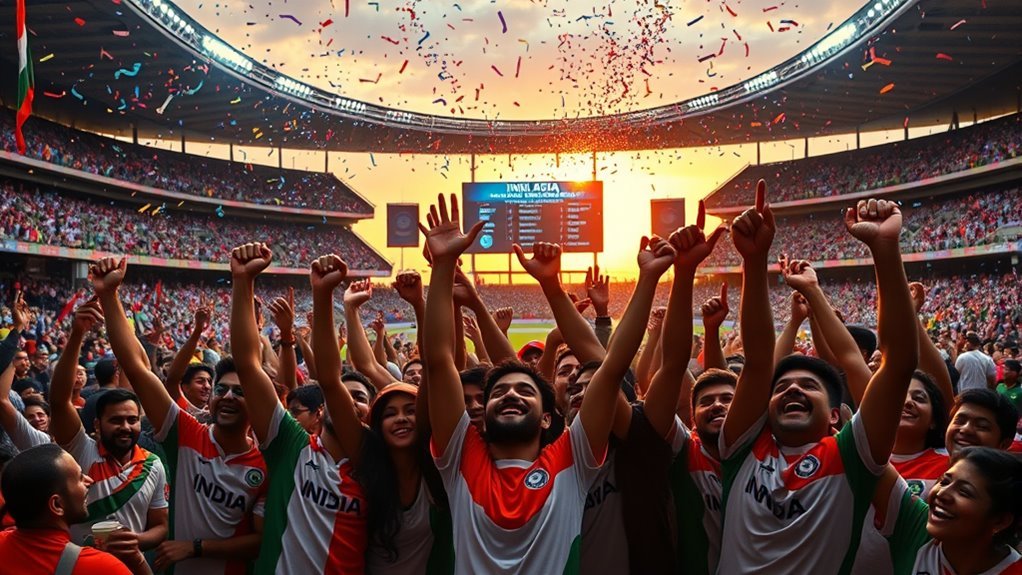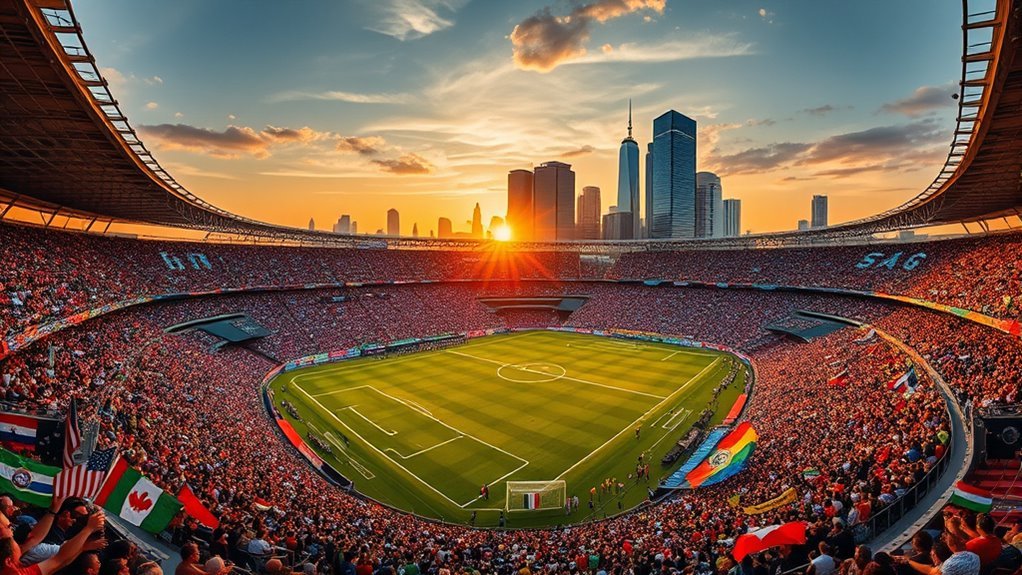The 2026 FIFA World Cup will be uniquely hosted by the United States, Canada, and Mexico—making it the first time this tournament is shared among three nations. It’s an exciting opportunity for each country to showcase their soccer culture and passion for the game. With innovative fan engagement technologies and expanded tournament formats, this World Cup promises to be a memorable event. Discover more about the impact on soccer in North America and the host cities.
Overview of the 2026 FIFA World Cup
As the excitement builds for the 2026 FIFA World Cup, it’s clear that this tournament will be unique in several ways. This is the first time three countries—Canada, the United States, and Mexico—will jointly host the event, showcasing a true celebration of global soccer. You’ll witness diverse cultures come together, creating an electrifying atmosphere that emphasizes unity and freedom through the beautiful game.
Fan engagement will reach new heights, with innovative technology and immersive experiences designed to bring you closer to the action. Expect interactive fan zones, virtual reality experiences, and enhanced connectivity that’ll make you feel part of the global soccer community, no matter where you are.
This World Cup isn’t just about the games; it’s about fostering connections among fans, players, and nations, allowing everyone to enjoy the spirit of competition and camaraderie like never before. Get ready for an unforgettable journey!
The United States: A Soccer Powerhouse
As you look at the rise of soccer in the United States, it’s clear that the sport’s popularity is skyrocketing. With high-quality infrastructure and facilities popping up across the country, fans are more excited than ever. Plus, the U.S. has a history of World Cup success that adds to the anticipation for 2026.
Soccer Popularity Surge
While many might associate soccer with Europe and South America, the United States has emerged as a formidable force in the sport, showcasing an undeniable surge in popularity. This growth can be attributed to several factors driving youth engagement and media influence:
- Increased youth participation in soccer leagues across the country.
- Major media networks broadcasting MLS and international matches, bringing the excitement into homes.
- The rise of soccer academies fostering young talent and promoting skill development.
- Social media platforms amplifying fan engagement and allowing for real-time discussions.
As you witness this evolution, you can appreciate how soccer has captured the hearts of many, positioning the U.S. as a true soccer powerhouse on the global stage.
Infrastructure and Facilities
When you consider the rapid growth of soccer in the United States, it’s evident that the infrastructure and facilities are evolving to meet the demands of this burgeoning popularity. Stadium upgrades are happening across the nation, enhancing fan experiences and creating an electric atmosphere for matches. These modern venues not only accommodate larger crowds but also offer state-of-the-art technology and amenities.
Transportation improvements are also essential. With enhanced public transit options and better roadways, getting to games will be easier than ever. Fans will have the freedom to travel seamlessly, ensuring they won’t miss the action. As the U.S. gears up for the 2026 World Cup, these developments signal a commitment to elevating soccer’s profile and providing unforgettable experiences for everyone involved.
Past World Cup Success
The United States has made significant strides in soccer, particularly during past World Cups, showcasing its potential as a soccer powerhouse. As you explore World Cup history, you’ll see how the U.S. has carved its niche among winning nations. Here are some highlights of their journey:
- Reached the semifinals in 1930, the inaugural World Cup.
- Qualified for the tournament 10 times, demonstrating consistent growth.
- Hosted the World Cup in 1994, boosting soccer’s popularity.
- Women’s team won four World Cups, proving dominance in women’s soccer.
These achievements reflect the U.S.’s commitment to the sport and its aspirations to become a leading force in global soccer. The future looks bright as the nation prepares to host the World Cup again in 2026.
Canada: Growing the Game
Canada’s enthusiasm for soccer is on the rise, and hosting the 2026 FIFA World Cup is a significant moment for the sport in the country. This event isn’t just about the games; it’s a chance for you to embrace and celebrate the beautiful game like never before. With a focus on youth programs and grassroots initiatives, Canada’s soccer community is laying the groundwork for future stars.
You’ll see local clubs springing up, providing opportunities for kids to play, learn, and connect with their peers. These initiatives are essential for fostering talent and passion, encouraging players of all ages to dream big. The World Cup will shine a spotlight on these efforts, inspiring a new generation to kick off their soccer journey. As Canada steps into the global soccer arena, you’ll witness the game’s growth and the freedom it brings to communities across the nation.
Mexico: A Rich Soccer Tradition
As you immerse yourself in the world of soccer in Mexico, you’ll quickly discover a rich tradition that runs deep through the nation’s culture. The soccer history here is not just a story; it’s a passion that unites millions. The fan culture is vibrant, filled with energy and pride, creating an unforgettable atmosphere at every match. Here are some key elements that define Mexico’s soccer tradition:
Soccer in Mexico is a vibrant passion, uniting millions and creating unforgettable match-day experiences.
- Historic Clubs: Teams like Club América and Chivas have loyal followings dating back decades.
- Iconic Players: Legends such as Hugo Sánchez and Rafael Márquez have inspired generations.
- Passionate Fans: You’ll find supporters who live and breathe their teams, showcasing creativity in chants and displays.
- International Success: Mexico’s consistent presence in World Cups reflects its strong soccer identity.
In Mexico, soccer isn’t just a game; it’s a way of life, embodying freedom and unity.
Expanding the Tournament Format
As we look ahead to the 2026 World Cup, you’ll notice significant changes in the tournament format. With increased team participation and an expanded match schedule, it’s set to be more exciting than ever. Plus, the diverse host locations promise to bring unique experiences to fans and players alike.
Increased Team Participation
With the FIFA World Cup 2026 set to expand its tournament format, fans can expect an exciting increase in team participation that promises to elevate the competition. This change highlights the importance of global competition and team diversity, allowing more nations to showcase their talents. Here’s what you can look forward to:
- More Teams: An increase from 32 to 48 teams, representing a wider array of countries.
- Diverse Playing Styles: Different tactics and techniques will enrich matches.
- New Opportunities: Lesser-known teams can gain exposure and experience on the world stage.
- Broader Fan Engagement: Fans from various regions will rally behind their national teams, enhancing the tournament’s spirit.
This expansion truly celebrates the essence of football!
Expanded Match Schedule
The increase in team participation for the FIFA World Cup 2026 brings with it a thorough expansion of the match schedule, promising fans even more thrilling action. With an expanded match format, you’ll experience a wider variety of teams showcasing their talents, leading to unforgettable moments on the pitch. However, this expansion also means managing complex schedule logistics to guarantee every match flows smoothly. Organizers are tasked with creating a balanced timetable that allows fans to catch all the excitement without overwhelming them. By embracing this expanded match schedule, you’ll revel in a festival of football that celebrates the spirit of competition and unity, offering you the freedom to cheer for your favorite teams and players like never before.
Diverse Host Locations
While many fans enthusiastically anticipate the excitement of the FIFA World Cup 2026, the diverse host locations add an extra layer of allure to the tournament. This event isn’t just about soccer; it’s a celebration of cultural exchange and regional collaboration. By spanning multiple countries, it offers you a unique chance to experience various cultures and communities.
Here are four key benefits of these diverse host locations:
- Cultural Immersion: Engage with different traditions and cuisines.
- Travel Opportunities: Explore iconic landmarks across countries.
- Fan Interaction: Meet diverse supporters and share experiences.
- Economic Boost: Local businesses thrive through increased tourism.
These factors make the tournament a truly global celebration, inviting everyone to partake in the joy of the game.
Host Cities and Venues
For the 2026 FIFA World Cup, a total of 16 cities across the United States, Canada, and Mexico will host matches, showcasing a diverse array of venues. You’ll see everything from iconic stadiums in major cities to newer facilities in vibrant communities. Each host city is gearing up with meticulous preparations, ensuring they can deliver an unforgettable experience to fans around the globe.
Venue selections have prioritized accessibility, atmosphere, and local culture, allowing each game to reflect the spirit of its surroundings. As you explore these cities, you’ll encounter unique fan experiences and local traditions that elevate the excitement of the tournament.
Whether you’re cheering in a bustling metropolis or a charming locale, the host cities promise to create memories that last a lifetime. So, get ready to embrace the energy and passion that each venue brings to the beautiful game!
Economic Impact on Host Nations
As nations prepare to host the 2026 FIFA World Cup, they’re not just gearing up for an exciting tournament; they’re also anticipating significant economic benefits. The event is expected to spur economic growth and attract global investment, which can transform local economies. Here are a few ways the host nations can expect to benefit:
- Increased Tourism: Millions of fans will flock to the host cities, boosting local hospitality and service industries.
- Job Creation: Temporary jobs in construction, event management, and hospitality will provide income and experience for many.
- Infrastructure Development: Investments in transport and facilities will improve local infrastructure, benefiting residents long after the event.
- Global Exposure: Hosting the World Cup enhances a country’s visibility on the world stage, attracting future investments and tourism.
In short, the 2026 FIFA World Cup promises not just an unforgettable experience but also a chance for substantial economic uplift.
The Future of Soccer in North America
The excitement surrounding the 2026 FIFA World Cup is set to leave a lasting impact on soccer in North America. You’ll see a surge in youth development programs as communities rally to harness this momentum. With the spotlight on the world’s game, grassroots initiatives will thrive, encouraging kids from all backgrounds to pick up a ball and play.
Imagine local leagues flourishing, providing opportunities for aspiring athletes to showcase their talent. Clubs will invest in training facilities, coaching, and mentorship, helping to cultivate the next generation of soccer stars. As you witness increased participation, the passion for the game will unify diverse communities, fostering a culture of inclusivity and teamwork. Additionally, focusing on nutrition for athletic performance will help young players maximize their potential on the field.
The World Cup isn’t just a tournament; it’s a chance to ignite a soccer revolution in North America. With your support, the future looks bright, vibrant, and full of potential for soccer lovers everywhere.
Frequently Asked Questions
How Many Teams Will Participate in the 2026 World Cup?
For the 2026 World Cup, 48 teams will participate in an expanded format. You’ll see more nations competing, which means exciting team qualifications and a chance for underdogs to showcase their talent on a global stage.
When Will the Tournament Take Place?
The tournament’s set for June to July 2026, where dreams ignite like fireworks. Expect thrilling kickoff times, and let your spirit soar as you embrace freedom, celebrating every moment of this grand spectacle together.
How Can Fans Purchase Tickets for the Event?
You can purchase tickets online through official platforms. Keep an eye on announcements for fan experiences, as they often provide exclusive opportunities. Don’t miss out on securing your spot at this exciting event!
Will There Be Any New Rules for the Tournament?
You bet there’ll be new rules! VAR implementation will be key, ensuring fair play, while player eligibility criteria might tighten. It’s all about keeping the game exciting and giving everyone a fair shot.
What Is the Official Mascot for the 2026 World Cup?
The official mascot for the 2026 World Cup hasn’t been disclosed yet. Expect a vibrant design that enhances fan engagement, celebrating freedom and unity through soccer. You’ll love the creativity behind it when it’s disclosed!




